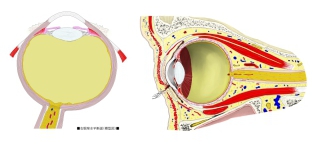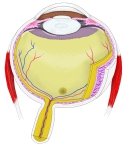




・「毛様体は虹彩支質と脈絡膜の移行部に生後発生する平滑筋(毛様体筋)の束により生じる肥厚部である。」(船戸和也のHP)







|
|
|
|
眼球・断面-1 |
眼球・断面-2 |
眼球前部・断面-1 |
眼球前部・断面-2 |
|
|
 |
|
眼球断面・模型図 |
毛様体・模型図 (眼球内面から見て) |
眼球・横断面-1 |
|


「 船戸和弥のHP 」では以下のように解説している。
毛様体は虹彩支質と脈絡膜の移行部に生後発生する平滑筋(毛様体筋)の束により生じる肥厚部である。経線断面では全体として三角形の断面をもち、3頂点がそれぞれ網膜鋸状縁、虹彩基部、毛様体突起にあたる。毛様体突起には毛様体小帯が結合し、水晶体に連絡する。眼球を赤道面で切断し、その前半分を後ろから観察すると水晶体を一周する毛様体を一眺することができる。鋸状縁につづく、①毛様体輪(幅~3mm)と、②放射状に配列する約70個の毛様体突起とヒダよりなる毛様体間が区別される。輪部には細い経線方向に走る稜線が認められ、これが集中して毛様体突起(長さ2mm、幅1mm、高さ0.5mm)をつくる。
以下は「Wikipedia」の解説文となる。
The ciliary body is a part of the eye that includes the ciliary muscle, which controls the shape of the lens, and the ciliary epithelium, which produces the aqueous humor. The aqueous humor is produced in the non-pigmented portion of the ciliary body.The ciliary body is part of the uvea, the layer of tissue that delivers oxygen and nutrients to the eye tissues. The ciliary body joins the ora serrata of the choroid to the root of the iris.
【 語 句 】
・ciliary muscle:毛様体筋 ・ciliay epithelium:毛様体上皮 ・aqueous humor:房水 ・non-pigmented:非色素の ・uvea:眼球血管膜 ・ora serrata:鋸状縁 ・choroid:脈絡膜 ・iris:虹彩
【Structure】
The ciliary body is a ring-shaped thickening of tissue inside the eye that divides the posterior chamber from the vitreous body. It contains the ciliary muscle, vessels, and fibrous connective tissue. Folds on the inner ciliary epithelium are called ciliary processes, and these secrete aqueous humor into the posterior chamber. The aqueous humor then flows through the pupil into the anterior chamber.
The ciliary body is attached to the lens by connective tissue called the zonular fibers (fibers of Zinn). Relaxation of the ciliary muscle puts tension on these fibers and changes the shape of the lens in order to focus light on the retina.
The inner layer is transparent and covers the vitreous body, and is continuous from the neural tissue of the retina. The outer layer is highly pigmented, continuous with the retinal pigment epithelium, and constitutes the cells of the dilator muscle. This double membrane is often considered continuous with the retina and a rudiment of the embryological correspondent to the retina. The inner layer is unpigmented until it reaches the iris, where it takes on pigment. The retina ends at the ora serrata.
【 語 句 】
・posterior chamber:後眼房 ・vitreous body:硝子体 ・ciliary process:毛様体突起 ・secrete:分泌する ・pupil:瞳孔 ・anterior chamber:前眼房 ・zonular fiber:小帯線維 ・retina:網膜 ・transparent:透明な ・retinal pigment epithelium:網膜色素上皮 ・constitute:構成要素となる ・dilator muscle: ・rudiment: ・embyological:
The parasympathetic innervation of the ciliary body is the most clearly understood. Presynaptic parasympathetic signals that originate in the Edinger-Westphal nucleus are carried by cranial nerve III (the oculomotor nerve) and travel through the ciliary ganglion. Postsynaptic fibers from the ciliary ganglion form the short ciliary nerves. Parasympathetic activation of the M3 muscarinic receptors causes ciliary muscle contraction, the effect of contraction is to decrease the diameter of the ring of ciliary muscle. The parasympathetic tone is dominant when a higher degree of accommodation of the lens is required, such as reading a book.
The ciliary body is also known to receive sympathetic innervation via long ciliary nerves. When test subjects are startled, their eyes automatically adjust for distance vision.
【 語 句 】
・parasympathetic:副交感神経の ・presynaptic:シナプス前の ・Edinger-Westphal nucleus:エディンガー・ウェストファル核 ・oculomotor nerve:動眼神経 ・postsynaptic fibers:節後繊維 ・short ciliary nerves:短毛様体神経 ・activation:活発化 ・muscarinic receptors:ムスカリン受容体 ・dominant:優勢な ・accomodation:視力調節 ・startle:びっくりさせる
【Function】
The ciliary body has three functions: accommodation, aqueous humor production and resorption, and maintenance of the lens zonules for the purpose of anchoring the lens in place.
■Accommodation■
Accommodation essentially means that when the ciliary muscle contracts, the lens becomes more convex, generally improving the focus for closer objects. When it relaxes, it flattens the lens, generally improving the focus for farther objects.
■Aqueous humor■
The ciliary epithelium of the ciliary processes produces aqueous humor, which is responsible for providing oxygen, nutrients, and metabolic waste removal to the lens and the cornea, which do not have their own blood supply. Eighty percent of aqueous humor production is carried out through active secretion mechanisms (the Na+K+ATPase enzyme creating an osmotic gradient for the passage of water into the posterior chamber) and twenty percent is produced through the ultrafiltration of plasma. Intraocular pressure affects the rate of ultrafiltration, but not secretion.
■Lens zonules■
The zonular fibers collectively make up the suspensory ligament of the lens. These provide strong attachments between the ciliary muscle and the capsule of the lens.
【 語 句 】
・resorption:(再)吸収 ・contract:収縮する ・convex:凸状の ・metabolic:代謝の ・cornea:角膜 ・enzyme:酵素 ・osmotic:浸透(性)の ・gradient:勾配 ・ultrafiltration:限外濾過 ・plasma:血漿 ・intraocular pressure:眼圧
■ 写真やイラストを掲載しているサイト ■
・ イラストや写真を掲載しているサイト-Ⅰ
・ イラストや写真を掲載しているサイト-Ⅱ
・ イラストや写真を掲載しているサイト-Ⅲ
・ イラストや写真を掲載しているサイト-Ⅳ
